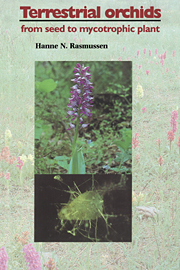Book contents
- Frontmatter
- Contents
- Acknowledgements
- Introduction
- 1 Properties of ‘dust’ seeds
- 2 Seed development
- 3 Seed survival
- 4 Requirements for germination
- 5 Fungi
- 6 Germination processes
- 7 Underground organs
- 8 Orchid mycorrhiza
- 9 Abiotic factors in growth and development
- 10 Life history and phenology
- 11 Propagation
- 12 Effects of orchid mycorrhiza
- 13 Descriptions of genera
- Appendix A Nutrient substrates mentioned in the text
- Appendix B Names and synonyms
- References
- Index
5 - Fungi
Published online by Cambridge University Press: 13 October 2009
- Frontmatter
- Contents
- Acknowledgements
- Introduction
- 1 Properties of ‘dust’ seeds
- 2 Seed development
- 3 Seed survival
- 4 Requirements for germination
- 5 Fungi
- 6 Germination processes
- 7 Underground organs
- 8 Orchid mycorrhiza
- 9 Abiotic factors in growth and development
- 10 Life history and phenology
- 11 Propagation
- 12 Effects of orchid mycorrhiza
- 13 Descriptions of genera
- Appendix A Nutrient substrates mentioned in the text
- Appendix B Names and synonyms
- References
- Index
Summary
Isolation
Orchid endophytes can be isolated from naturally occurring protocorms, from roots, and occasionally from rhizomes, tubers or corms. The advantage of extracting a fungus from protocorm tissue is that its role in seedling development may almost be taken for granted, whereas organs of mature plants may house a variety of fungi (Harvais & Hadley, 1967a; Hadley, 1970b). Furthermore, infection is extensive in the basal part of the protocorm, and protocorm cells are often fairly large. In contrast, the cortical cells of roots are long and narrow and the infection tends to be patchy and irregular. The most promising places to search for infection in roots are areas of the cortex below epidermal hairs, especially those close to the root tip (Bernard, 1909). Infected parts of an orchid root tend to become faintly yellowish or opaque. The living pelotons, where present, will be found close to the surface of the organ.
When the rhizome is infected it is usually the outer cortex that is most suitable for isolation purposes. In Liparis lilifolia both the condensed rhizome and the bases of attached leaves are infected. Isolation from tubers of orchidoid species has apparently never been successful, although Fuchs & Ziegenspeck (1925) report that superficial cell layers of globose tubers may be infected as well as the extremities of palmately divided tubers. Corms are usually without infection (Chapter 7).
Care must always be taken to remove the soil organisms that are normally found on any underground plant parts. Fungi that occur in the rhizosphere can include strains of Rhizoctonia that differ from those that form pelotons inside, and their relevance for the orchid mycorrhiza is not clear (Warcup & Talbot, 1967).
- Type
- Chapter
- Information
- Terrestrial OrchidsFrom Seed to Mycotrophic Plant, pp. 77 - 112Publisher: Cambridge University PressPrint publication year: 1995
- 1
- Cited by



